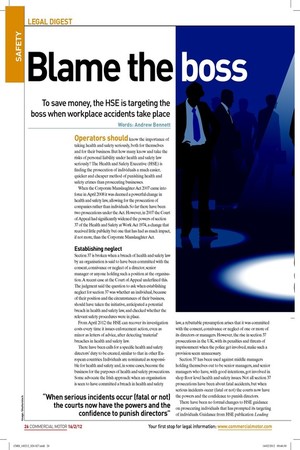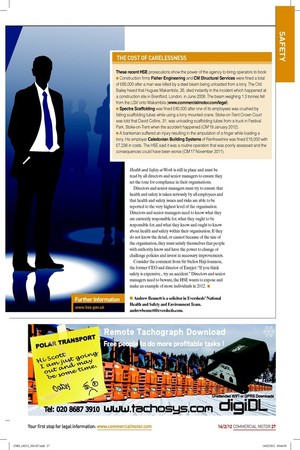Blame the boss
Page 22

Page 23

If you've noticed an error in this article please click here to report it so we can fix it.
To save money, the HSE is targeting the boss when workplace accidents take place
Words: Andrew Bennett Operators should know the importance of taking health and safety seriously, both for themselves and for their business. But how many know and take the risks of personal liability under health and safety law seriously? The Health and Safety Executive (HSE) is inding the prosecution of individuals a much easier, quicker and cheaper method of punishing health and safety crimes than prosecuting businesses.
When the Corporate Manslaughter Act 2007 came into force in April 2008 it was deemed a powerful change in health and safety law, allowing for the prosecution of companies rather than individuals. So far there have been two prosecutions under the Act. However, in 2007 the Court of Appeal had signiicantly widened the powers of section 37 of the Health and Safety at Work Act 1974, a change that received little publicity but one that has had as much impact, if not more, than the Corporate Manslaughter Act.
Establishing neglect
Section 37 is broken when a breach of health and safety law by an organisation is said to have been committed with the consent, connivance or neglect of a director, senior manager or anyone holding such a position at the organisation. A recent case at the Court of Appeal underlined this. The judgment said the question to ask when establishing neglect for section 37 was whether an individual, because of their position and the circumstances of their business, should have taken the initiative, anticipated a potential breach in health and safety law, and checked whether the relevant safety procedures were in place.
From April 2012 the HSE can recover its investigation costs every time it issues enforcement action, even as minor as letters of advice, after detecting ‘material’ breaches in health and safety law.
There have been calls for a speciic health and safety directors’ duty to be created, similar to that in other European countries. Individuals are nominated as responsible for health and safety and, in some cases, become the business for the purposes of health and safety prosecutions. Some advocate the Irish approach: when an organisation is seen to have committed a breach in health and safety law, a rebuttable presumption arises that it was committed with the consent, connivance or neglect of one or more of its directors or managers. However, the rise in section 37 prosecutions in the UK, with its penalties and threats of imprisonment when the police get involved, make such a provision seem unnecessary.
Section 37 has been used against middle managers holding themselves out to be senior managers, and senior managers who have, with good intentions, got involved in shop loor level health and safety issues. Not all section 37 prosecutions have been about fatal accidents, but when serious incidents occur (fatal or not) the courts now have the powers and the conidence to punish directors.
There have been no formal changes to HSE guidance on prosecuting individuals that has prompted its targeting of individuals. Guidance from HSE publication Leading Health and Safety at Work is still in place and must be read by all directors and senior managers to ensure they set the tone for compliance in their organisations.
Directors and senior managers must try to ensure that health and safety is taken seriously by all employees and that health and safety issues and risks are able to be reported to the very highest level of the organisation. Directors and senior managers need to know what they are currently responsible for, what they ought to be responsible for, and what they know and ought to know about health and safety within their organisation. If they do not know the detail, or cannot because of the size of the organisation, they must satisfy themselves that people with authority know and have the power to change or challenge policies and invest in necessary improvements.
Consider the comment from Sir Stelios Haji-loannou, the former CEO and director of Easyjet: “If you think safety is expensive... try an accident.” Directors and senior managers need to beware, the HSE wants to expose and make an example of more individuals in 2012. ■ • Andrew Bennett is a solicitor in Eversheds’ National Health and Safety and Environment Team. andrewbennett@eversheds.com.
THE COST OF CARELESSNESS
These recent HSE prosecutions show the power of the agency to bring operators to book:
• Construction firms Fisher Engineering and CM Structural Services were fined a total of £65,000 after a man was killed by a steel beam being unloaded from a lorry. The Old Bailey heard that Hugues Makambila, 35, died instantly in the incident which happened at a construction site in Brentford, London, in June 2008. The beam weighing 1.3 tonnes fell from the LGV onto Makambila (www.commercialmotor.com/legal).
• Spectra Scaffolding was fined £40,000 after one of its employees was crushed by falling scaffolding tubes while using a lorry mounted crane. Stoke-on-Trent Crown Court was told that David Collins, 31, was unloading scaffolding tubes from a truck in Festival Park, Stoke-on-Trent when the accident happened (CM 19 January 2012).
• A banksman suffered an injury resulting in the amputation of a finger while loading a lorry. His employer Caledonian Building Systems of Renfrewshire was fined £15,000 with £7,238 in costs. The HSE said it was a routine operation that was poorly assessed and the consequences could have been worse (CM 17 November 2011).














































